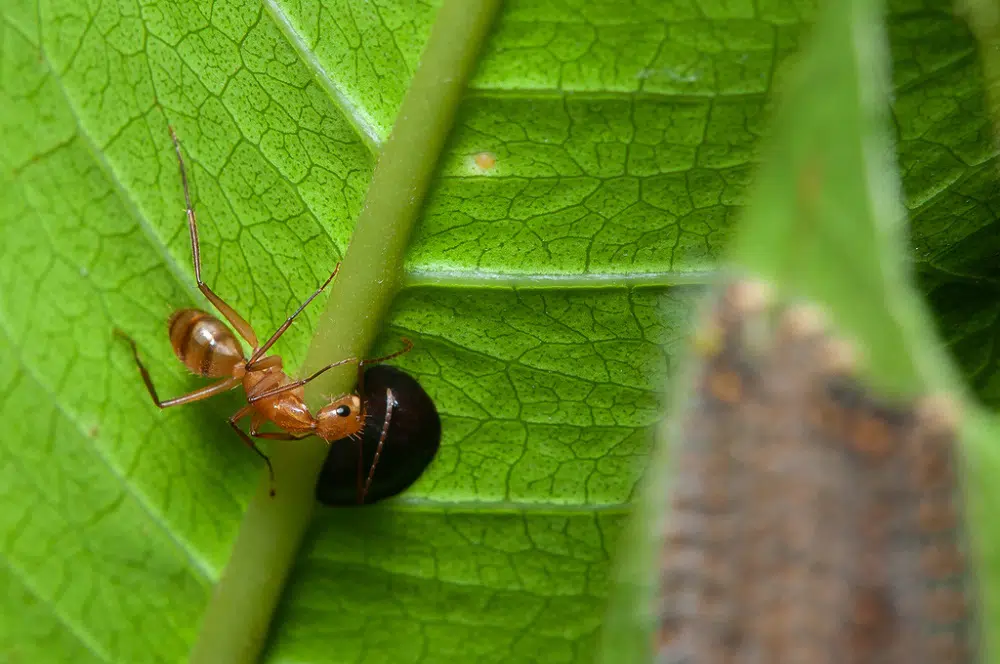There are many types of ants in Florida. Most of them aren’t found in homes as pests.
Ants can be seen in Florida most months of the year. Some ants are even active in Florida’s rainy season (May-July) while others only appear later in the season.
Here are the most common species of ants found in Florida.
Table of Contents
1. Florida Carpenter Ant
The Florida Carpenter Ant (Camponotus floridanus) is widely distributed across the state with the exception of the Southern regions.
These ants are bi-colored and easy to recognize. The head and the thorax are brown or ash-brown while the gaster (abdomen) is black.
Being carpenter ants, these species nest in wood. They are often associated with wood-damaging carpenter ants.

However, Florida Carpenter Ants only use the excavated sections of wood by other ant species. Alternatively, they make their way through very damaged sections of wood being less aggressive to homeowners than other carpenter ants.
Some data suggests Florida Carpenter Ants are among the species mostly found in the walls of urban homes of the state.
They are very common in Orlando, Tampa Bay, and around Miami.
2. Red Imported Fire Ant

Red Imported Fire Ants (Solenopsis invicta) made their way to the US from South America.
It’s believed this invasive species was introduced to Florida starting in 1933.
Most Red Imported Fire Ants grow between 2 and 10mm. They are red to brown.
These ants don’t live long as most tend to have a lifespan of 30 to 90 days.
Red Imported Fire ants can bite and sting and they should be avoided by humans. The species is known to become aggressive when disturbed.
Studies show its bites aren’t painful. It’s the sting of these ants that comes with painful alkaloids.
Red Fire Ants are foragers. They are seen looking for food such as dead animals, dead insects, dead worms, and other vertebrates.
Occasionally, these ants will seek out honeydew. They are also found in homes, most likely attracted by food or dirty laundry.
3. Florida Harvester Ant

These common Florida ants (Pogonomyrmex badius) are mostly dark rusty red. They can be further distinguished by other dark red ants by the presence of long hairs on the ventral side.
Worker Florida Harvester Ants are polymorphic (they come in different sizes) and they can have other color variations.
Florida Harvester Ants are found in woodlands, particularly in open sandy areas (they build nests in the ground).
These ants are harvesters which means they pick up food and store it back in the nest.
Florida Harvester ants are known for collecting various types of seeds. These are stored in complex areas of dedicated storage areas in their underground nests.
The species can pick up various seeds off the ground but it can also pluck them out directly. These seeds are mostly ragweed and crabgrass.
4. Buren’s Pyramid Ant

Buren’s Pyramid Ants (Dorymyrmex bureni) are common in soft sandy soils and open woodlands across Florida and the rest of the US.
These ants are known for having a single node between the thorax and the abdomen but are popular due to their nests that look like small pyramids.
The excavated ground is piled up similarly to a pyramid which inspires the name of the species.
These ants rarely build a nest in very remote areas as they prefer to build nests next to the nest of harvester ants as they steal their food.
These ants aren’t seen as a major threat to Florida homes as they prefer to live outdoors in excavated soils. They might still make their way indoors shortly, mainly in search of food and water.
5. Graceful Twig Ant

These ants (Pseudomyrmex gracilis) are orange-brown or brown-black. They grow between 8 and 10mm and are characterized by 2 large eyes and a body that resembles wasps.
Graceful Twig Ants don’t have very specific nesting preferences as they are seen in different environments.
However, there are specific areas in Florida in these ants can be seen. They are seen on acacia trees in the state.
These ants aren’t seen as pests as they don’t live inside homes. However, they should still be avoided by people as they have a very painful sting.
6. Compact Carpenter Ant

The Compact Carpenter Ant (Camponotus planatus) is still a species of ants with an uncertain name. It has a pest status in Florida as an arboreal ant species that cause structural damages to homes.
The species is mostly associated with Florida Carpenter Ants in behavior.
In fact, Compact Carpenter Ants are almost always found nesting in the proximity of Florida Carpenter Ants.
Tampa, East Miami, and the Florida Keys are the main habitats of the species in the state.
These ants are known for growing to a maximum length between 3 and 6 ants.
Coloring is shared with other carpenter ants as they have an ash brown thorax and a brown-black abdomen.
These ants have no stingers.
Compact Carpenter Ants are diurnal species (unlike many other carpenter ants) which means they are routinely seen around the house.
The species has the tendency to be seen mostly on the outer walls of a home and on rare occasions indoors.
Compact Florida Carpenter Ants nest in hollow twigs and old wood galleries dug by other ants and termites. The nest is always found in dead wood.
7. Longhorn Crazy Ant

Longhorn Crazy Ants (Paratrechina longicornis) have dark-brow bodies. They also show gray to white hairs.
These ants have had a pest status in Florida since the early ‘30s.
Most Longhorn Crazy Ants are known for living both in dry and humid habitats indoors and outdoors.
The easiest way to find the nest of these ants is to follow an individual carrying food as they tend to store seeds and other foods inside the nest.
They are attracted to open food inside the house. Eliminating these ants from homes mostly involves storing all foods away.
Various foods attract these ants. It’s believed they like sugary foods such as fruits during the summer.
They prefer protein-rich foods such as dead insects in the spring.
8. Large Imported Big-headed Ant

The species (Pheidole obscurithorax) is seen as a pest in South Florida.
These ants are recognized by a dark red body color that almost appears brown. These ants are known for having a cast of workers which exhibit a larger head in comparison to the abdomen.
Sparse long hairs are also seen on these ants.
These pests have predatory behavior. They even eat other ants.
9. Ghost Ant

Ghost Ants (Tapinoma melanocephalum) are pests in regions of Florida such as Gainesville and Orlando.
These are small ants that grow to a maximum of 1.5mm. They are bicolored ants that are easy to recognize due to their contrasting colors.
The head and thorax are dark brown, almost black. Gasters and legs are white.
Ghost ants are seen as major pests as they can nest indoors as well as outdoors.
These ants have normally been seen nesting in areas where larger colony ants don’t colonize. They are mostly attracted to sweets and sweet foods found inside homes.
One of the biggest issues caused by Ghost ants in Florida is the invasion of greenhouses. This means that insecticides aren’t an option for keeping them out.
It’s recommended to maintain both homes and greenhouses as clean as possible to avoid Ghost ants invasion.
10. Florida Trap-jaw Ant

The species (Odontomachus brunneus) is common in Southern Florida.
It’s recognized by a dark almost black shiny body without hairs and very long strong mandibles.
These mandibles open widely up to 180 degrees to catch prey.
Florida trap-jaw ants nest both in soft sandy soils and soft rotten wood.
These nests are built to very specific standards. They are almost vertical with a few almost horizontal chambers across the nest.
Ants of the genus are known as urban pest ants.
11. African Big-headed Ant

This species (Pheidole megacephala) is common in South Florida.
These ants are known to be very aggressive. They are often named among the most important pests around the world.
African Big-headed ants get their name from their large heads. These large heads account for almost half of an ant’s body.
Their pests status is increasing in Florida where can disturb entire ecosystems.
They are known to drive out all types of invertebrates from certain habitats and this includes other ant species.
12. Chestnut Carpenter Ant

Chestnut Carpenter Ants (Camponotus castaneus) are known to be carrier hoses of nematodes.
These ants are recognized by a red-orange color across the body and legs.
These ants aren’t regularly seen during the day as they are mostly nocturnal.
Chestnut Carpenter ants nest in soil. They prefer high humidity under rocks and logs. They sometimes nest in rotten logs on the ground.
13. Northern Fungus-farming Ant

The Northern Fungus-farming Ant (Trachymyrmex septentrionalis) has widespread US distribution. It has a long lifespan in the country but they remain active through the winter in the warm Florida climate.
These ants are commonly found in sandy soils next to pine forests. They have been shown to only choose these types of soils as they nest in the ground.
A common Northern Fungus-farming ant nest goes inches deep into the ground with the main tunnel connected to multiple other small chambers.
These tunnels are sometimes used for hibernation but since the species doesn’t hibernate in Florida, these nests are used through the year normally.
14. Dark Rover Ant

Dark Rover Ants (Brachymyrmex patagonicus) are native to South America with incipient distribution in the US, mostly in Florida.
These are small brown-black ants with short white scattered hairs across the body but not on the legs.
Dark Rover ants are small in comparison to other local species as they averagely measure 2mm.
These ants live in small colonies in the ground. They are also found indoors as an emerging pest.
However, cases of indoor invasions are rare in Florida compared to cases in other Southern states such as Texas where it’s believed they’re making their way indoors for high humidity in bathrooms and kitchens.
Since the pest status of the species is still unclear, there’s not much known about the management of Dark Rover Ants.
These ants can choose to leave trail scents that indicate there’s a chance for these foragers to invade a habitat, especially in the dry summer season.
15. Rough-node Snapping Ant

Rough-node Snapping Ants (Odontomachus ruginodis) are known to live in tropical and sub-tropical climates. They are scarcely present in Florida.
These ants are known for their long mandibles and for building atypically-small colonies.
Most colonies of these species only number a few hundred individuals.
These ants are known predators making the most of their large mandibles. Their mandibles open wide to 180 degrees and then shut with high force capturing prey efficiently.
16. Obscure Rover Ant

These ants (Brachymyrmex obscurior) have a pale yellow or black coloring with white scarce hairs on the body.
Males are the smallest type of Obscure Rover ants as they only grow up to 1.5mm.
Female ants are larger growing to 0.4mm while queens are the largest as they grow to 4.3mm.
17. Camponotus zonatus

This species of ants made its way to Florida from Costa Rica. Ants of the family are identified by a brown color or yellow color (in the case of the worker cast).
Most ants of the genus are nocturnal and rarely seen during the day. They inhabit dry forests and they’re known as opportunistic when it comes to nesting.
These ants will inhabit any type of crevice they find and they’re also known for often changing nest locations.
18. Six-Spotted Carpenter Ant

The Six-Spotted Carpenter Ant (Camponotus sexguttatus) is known for the wide range of colors it’s seen in. These colors range from bright to dark such as yellow or brown.
The species isn’t a Florida native but it has regions of the state where it’s the most common type of arboreal ant.
These regions include Brevard, Glades, and St. Lucie.
Six-Spotted Carpenter Ants are known for nesting in decaying wood. They are recognized by a small thorax and a large hairy abdomen.
Further Reading: